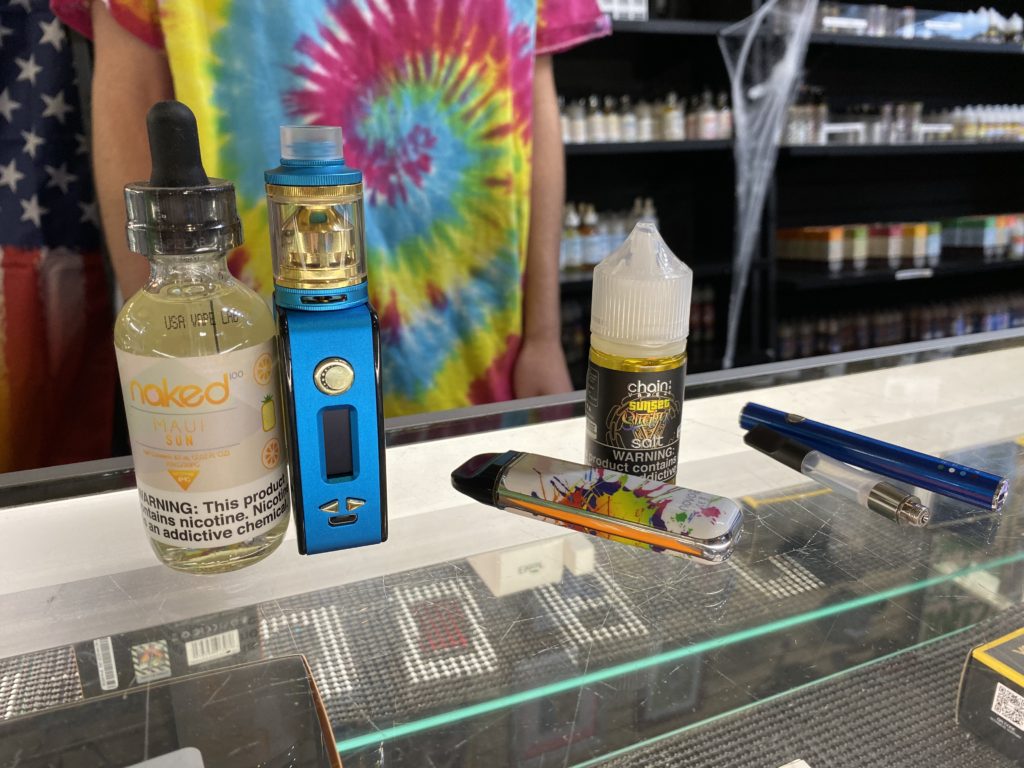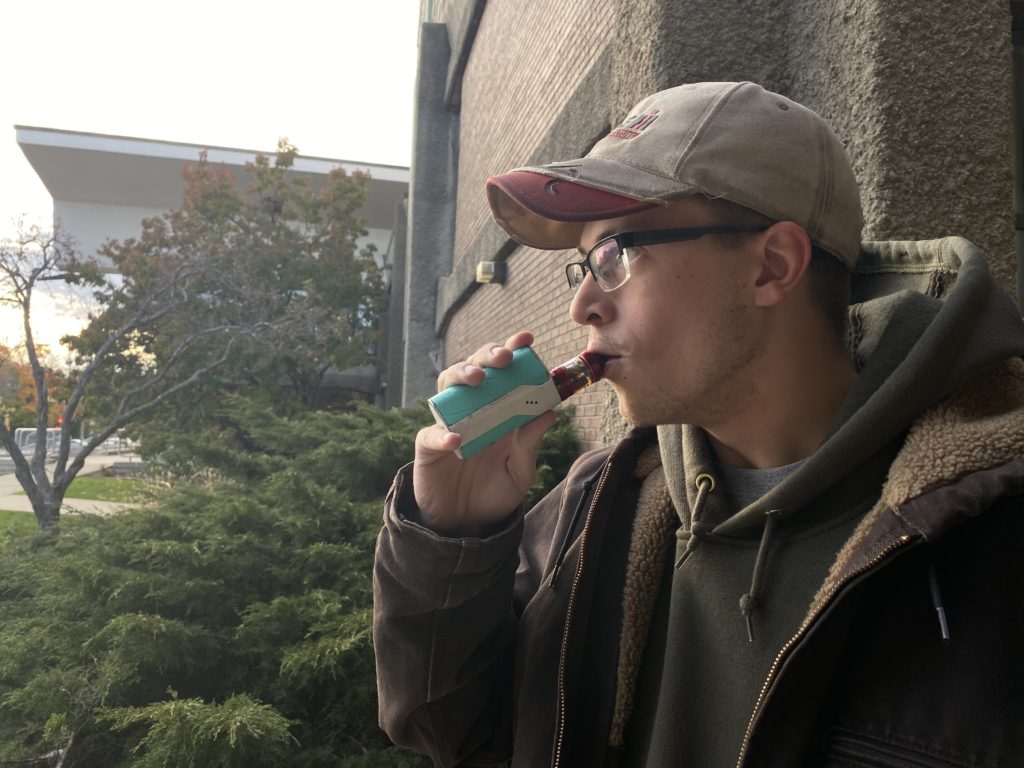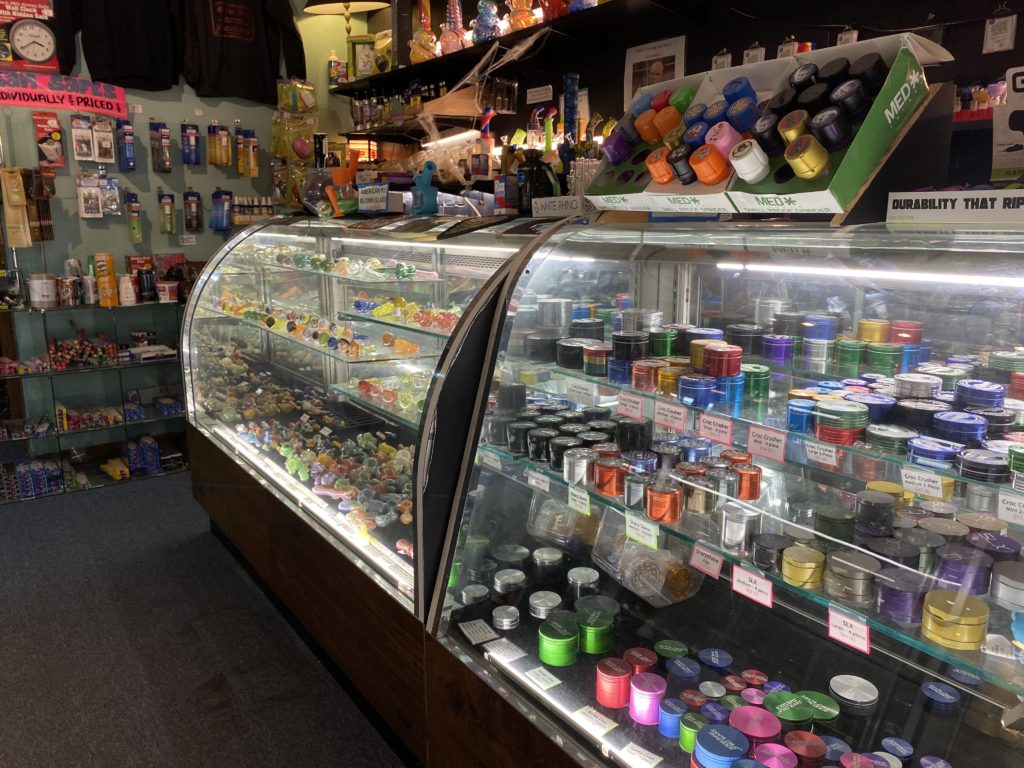He was sick of cigarettes. He was sick of his skin being discolored from the carbon monoxide-filled smoke that passed through his lips with each draw. The yellowing of his teeth was becoming more noticeable. Smoking a pack and a half every day was hitting his health and his wallet.
Enough was enough. Jake Oteman bought a vaping device to replace his Marlboro Lights.
Oteman is one of the many people who are trying to kick smoking to the curb by vaping. However, as of Oct. 29, 37 people have died from electronic cigarette or vaping products use associated lung injury, known as EVALI, according to the Centers for Disease Control and Prevention. Cigarettes kill more than half a million people per year, but the mystery surrounding reports of vaping illnesses and deaths is causing uncertainty among smokers and vapers alike.
The difference between smoking and vaping is combustion and tobacco. Smoking is the combusting of tobacco that creates smoke that is inhaled into the lungs. Vaping doesn’t have tobacco, and there’s no combustion. A flavored nicotine solution is heated until it becomes a vapor and is inhaled into the lungs. Initially, vaping companies were unable to provide adequate nicotine to keep up with cigarettes. Juul Labs, Inc., the leading e-cigarette company, had the technological breakthrough that allows people to inhale vapor deeper into the lungs, enabling nicotine to be absorbed more effectively into the bloodstream.

In September, the Trump administration proposed to ban all flavored vaping products except tobacco flavors. Though cigarettes kill far more people every year, there’s no push to ban them. There are three key reasons why the tobacco industry isn’t seeing a push to ban tobacco products, according to Dr. Doug Jorenby, director of clinical services at the University of Wisconsin Center for Tobacco Research and Intervention: the economy, history and the merging of companies.
Economy
The tobacco industry created over $12 billion in tax revenue in 2018, according to the Alcohol and Tobacco Tax and Trade Bureau report. In Wisconsin, the tobacco industry generated $757.8 million in revenue in 2019, according to the nonprofit Truth Initiative.
“Tobacco companies do bring in a lot of money, and they share some of that money with people that make laws about what is or isn’t permitted to be sold,” said Jorenby.
Two of the largest tobacco companies, Altria and Reynolds American, gave President Trump $1.5 million during his inauguration, according to Campaign for Tobacco Free Kids. During the current 2019 to 2020 election cycle, the Tobacco Company Political Action Committees have contributed over $1.2 million to politicians across the U.S., according to the Center for Responsive Politics.
History
Tobacco has roots in American history. It has been smoked for 2,000 years. Native Americans used tobacco for religious and medicinal purposes. Established in 1760, the Lorillard Tobacco Company was the first American tobacco company. Tobacco financed the Revolutionary War. Cigarettes were something that was rationed for soldiers during the world wars.

Vaping is new, making it the target of criticism. The first e-cigarette was patented 56 years ago, but the idea didn’t catch on. In 2003, a Chinese pharmacist developed an improved e-cigarette and e-juice. Still, it wasn’t until 2006 when vaping products made their way to the U.S.
Companies merge
There’s no longer a clear line between tobacco companies and e-cigarette companies. Major tobacco companies have either launched vaping companies of their own or bought already established companies.
The leading tobacco company, Altria, bought 35% of Juul, the leading e-cigarette company. The second most popular e-cigarette company, Vuse, is owned by tobacco company Reynolds American. Imperial Brands tobacco owns the e-cigarette brand Blu.
Although these three major differences may partially explain why there’s an emphasis on vaping bans and not smoking bans, Jorenby doesn’t think it’s enough.
What officials do know about vaping is that people have allergic reactions to e-juice flavorings and that vapers have been poisoned from the toxic levels of nicotine. Vaping causes popcorn lungs, or bronchiolitis obliterans, an irreversible disease that damages airways and results in coughing and shortness of breath, according to the American Lung Association. The primary illness from vaping is acute pulmonary disease. However, FDA approved products aren’t to blame. Officials are looking toward the black market for answers.
“Once this black-market thing is squared away, it’s going to end up being the case that well-manufactured, quality-controlled vaping products are almost certainly lower risk than smoking. How much lower? That remains to be seen,” said Jorenby.
Morgan Anderberg works at Knuckleheads Tobacco & Vape in Milwaukee. Customers are more cautious about purchasing vape products now than before, she said, but they’re starting to realize the issue is mainly black-market products, she said.
“It was found out that it was black market THC cartridges that was the big issue,” said Anderberg. “With the e-liquid, it’s FDA approved, so there’s no added chemicals that could harm you that they’ve found out so far.”

Dr. Daniel Shodell, Deputy Director of the Disease Control and Environmental Epidemiology Department at the Colorado Department of Public Health and Environment, disagrees.
“Some cases have reported vaping nicotine only, and a cause of the illness has not yet been identified,” he said. “No pattern has emerged that explains smaller versus larger numbers of case counts in across states. As we work with our local, state, and national partners to pinpoint the cause of the illness, we hope that becomes clearer.”
Despite the uncertainty, Jake Oteman will continue to use vape products.
“I feel floaty,” he said. “It’s such a good feeling.”